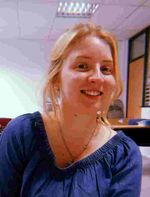Anna Hempel, geb. Rybecky

Smut fungi constitute the second largest group of plant pathogens subsequent to the rusts fungi. The members of this group affect grasses of the Poaceae family, including economically relevant crops worldwide.
Most smut fungi colonize their host plants systemically and produce symptoms in the inflorescences, where teliospores are formed. A peculiar exception is the smut fungus Ustilago maydis. This pathogen presents a bio-trophic lifestyle, being able to produce tumors in all aerial parts of its host maize trough organ-specific effectors.
U.maydis has a compact genome, is amenable to reverse genetics and adaptable to grow under laboratory conditions. These traits and the well establish plant-pathogen system, make it a model organism to understand the biology of functional effectors and bio-trophic fungal lifestyle.
Secreted effector proteins play a vital role during colonization and tumor formation. Parasitic interactions evolve toward the variation of effector repertoire. This evolution is caused by alterations between the pathogen population to overcome plant immune responses. Based on our current knowledge on effector function and evolution, we propose a model, which classifies effectors in functional categories that correlate with co-evolution of pathogen and host plants.
To functionally study effector genes and their transcriptional regulation in Ustilago maydis and its closely related maize pathogen Sporisorium reilianum, we are generating a tool box with artificial gene modules. These genetic constructs represent different parts of genes as independent entities, able to be combined unrestricted between them from the same or different species, allowing the formation tailor-made gene clusters which allow the temporally and spatially defined expression of individual effector genes. This approach aims to define the role of effectors at specific stages of infection, as well as to understand how transcriptional regulation of effectors defines their function in virulence.
A long term vision of this approach is to understand the biology of obligate pathogens not amenable to reverse genetics by combining modules well establish in Ustilago maydis with unknown effectors of organisms such as the bio-trophic rust fungi.
PhD Student
Anna Rybecky
University of Cologne
CEPLAS / Institiute for Plant Sciences
Chair of Terrestrial Microbiology
Zülpicher Straße 47a
D-50674 Cologne
Tel: +49 221-470-7831
Fax: +49 221-470-7406
Mail: arybecky@uni-koeln.de